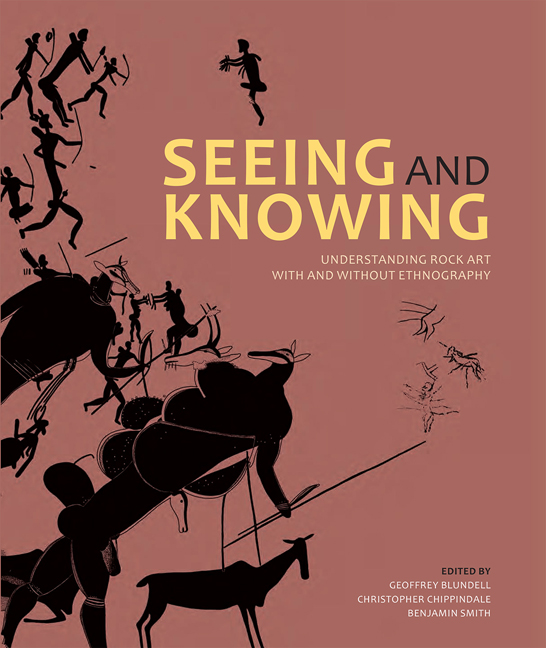Book contents
- Frontmatter
- Dedication
- Contents
- Contributors
- Acronyms
- Chapter 1 Rock art with and without ethnography
- Chapter 2 Flashes of brilliance: San rock paintings of heaven's things
- Chapter 3 Snake and veil: The rock engravings of Driekopseiland, Northern Cape South Africa
- Chapter 4 Cups and saucers: A preliminary investigation of the rock carvings of Tsodilo Hills, northern Botswana
- Chapter 5 Art and authorship in southern African rock art: Examining the Limpopo-Shashe Confluence Area
- Chapter 6 Archaeology, ethnography, and rock art: A modern-day study from Tanzania
- Chapter 7 Art and belief: The ever-changing and the never-changing in the Far west
- Chapter 8 Crow Indian elk love-medicine and rock art in Montana and Wyoming
- Chapter 9 Layer by layer: Precision and accuracy in rock art recording and dating
- Chapter 10 From the tyranny of the figures to the interrelationship between myths, rock art and their surfaces
- Chapter 11 Composite creatures in European Palaeolithic art
- Chapter 12 Thinking strings: On theory, shifts and conceptual issues in the study of Palaeolithic art
- Chapter 13 Rock art without ethnography? A history of attitude to rock art and landscape at Frøysjøen, western norway
- Chapter 14 ‘Meaning cannot rest or stay the same’
- Chapter 15 Manica rock art in contemporary society
- Chapter 16 Oral tradition, ethnography, and the practice of north American archaeology
- Chapter 17 Beyond rock art: Archaeological interpretation and the shamanic frame
- List of figures
- List of tables
- List of publications by david Lewis-williams
- Index
Chapter 1 - Rock art with and without ethnography
Published online by Cambridge University Press: 21 April 2018
- Frontmatter
- Dedication
- Contents
- Contributors
- Acronyms
- Chapter 1 Rock art with and without ethnography
- Chapter 2 Flashes of brilliance: San rock paintings of heaven's things
- Chapter 3 Snake and veil: The rock engravings of Driekopseiland, Northern Cape South Africa
- Chapter 4 Cups and saucers: A preliminary investigation of the rock carvings of Tsodilo Hills, northern Botswana
- Chapter 5 Art and authorship in southern African rock art: Examining the Limpopo-Shashe Confluence Area
- Chapter 6 Archaeology, ethnography, and rock art: A modern-day study from Tanzania
- Chapter 7 Art and belief: The ever-changing and the never-changing in the Far west
- Chapter 8 Crow Indian elk love-medicine and rock art in Montana and Wyoming
- Chapter 9 Layer by layer: Precision and accuracy in rock art recording and dating
- Chapter 10 From the tyranny of the figures to the interrelationship between myths, rock art and their surfaces
- Chapter 11 Composite creatures in European Palaeolithic art
- Chapter 12 Thinking strings: On theory, shifts and conceptual issues in the study of Palaeolithic art
- Chapter 13 Rock art without ethnography? A history of attitude to rock art and landscape at Frøysjøen, western norway
- Chapter 14 ‘Meaning cannot rest or stay the same’
- Chapter 15 Manica rock art in contemporary society
- Chapter 16 Oral tradition, ethnography, and the practice of north American archaeology
- Chapter 17 Beyond rock art: Archaeological interpretation and the shamanic frame
- List of figures
- List of tables
- List of publications by david Lewis-williams
- Index
Summary
THE LEWIS-WILLIAMS REVOLUTION: studying rock art in southern africa and beyond
The overall theme and structure of this book serve to explore how best we study rock art when there exist ethnographic or ethnohistoric bases of insight, and how we study rock art when there do not appear to be ethnographic or ethnohistoric bases of insight – in short, how we understand and learn from rock art with and without ethnography. We are not aware of an exact precedent for this, although the way archaeologists work best with and without ethnography is a perpetual issue of the discipline.
The ten years between 1967 and 1977 were, we can now see, a revolutionary period in southern African rock art research. In those years the older, colonial approaches to studying San rock art were rejected and replaced with approaches based on San cognition and ethnohistory – concerns which continue to be strong in the region and are increasingly influential outside it. In particular, studies of the meanings of San rock art have received wide notice.
This is more than a local or a regional concern. For a century – ever since the unexpected discoveries of Ice Age rock art in its deep caves astonished Europe – researchers have found rock art difficult. Striking though it often is in its aesthetic force, it has been hard to date and hard to make sense of within conventional archaeological frameworks. So observant, so well done, so accomplished, it must have meant something in ancient times – but what? In South Africa, David Lewis-Williams has accurately called the well-meaning and unhappy approaches that resulted ‘gaze and guess’ (Lewis-Williams & Dowson 2000). Guesses have come and gone in passing fashions over the decades as archaeologists have struggled with rock art – from totemism to sympathetic magic to aesthetic self-enjoyment to daily narrative to structuralism, back to totemism (Jones 1967) and so on – in a way that gives no confidence that the present fashion will be more than a passing phase, or even that knowledge accumulates, building and extending from stage to stage. Ideas seem just to flit about, one sometimes popular and one sometimes not, within much the same level of necessary ignorance.
- Type
- Chapter
- Information
- Seeing and KnowingUnderstanding Rock Art With and Without Ethnography, pp. 1 - 9Publisher: Wits University PressPrint publication year: 2010



